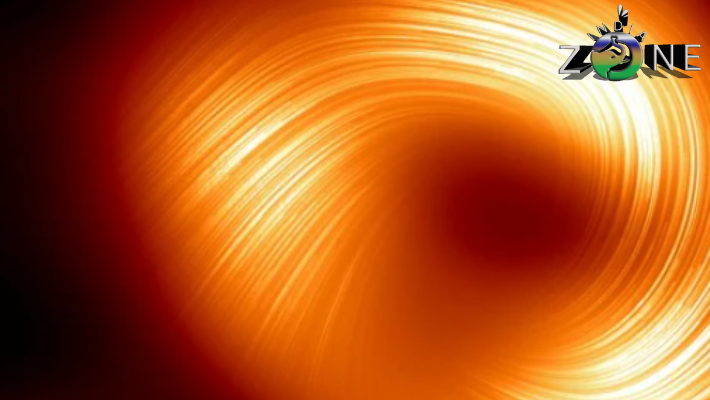
A new perspective on the gigantic object at the center of our galaxy has been acquired by the Event Horizon Telescope (EHT) collaboration. This cooperation created the first photograph of our Milky Way black hole, which was revealed in 2022. The image shows the object in polarized light. This is the first time polarization, a magnetic field signature, has been measured this near to the border of Sagittarius A* by astronomers. The polarized view of the Milky Way black hole is displayed in this image. The orientation of polarization, which is correlated with the magnetic field around the black hole’s shadow, is indicated by the lines superimposed on this picture. (Image courtesy of REUTERS)
A powerful and finely tuned magnetic field, finely twisted in a spiral pattern, envelops the supermassive black hole at the center of our Milky Way galaxy, according to a discovery made public by astronomers on Wednesday. This enormous finding provides hitherto unheard-of insights into the tremendous power and effect of this cosmic giant by revealing hitherto undiscovered features of it.
The magnetic field structure surrounding the primary black hole of the Milky Way, Sagittarius A* (Sgr A*), is similar to that of the black hole M87* in the nearby galaxy Messier 87 (M87). These striking similarities point to the possibility that strong magnetic fields are a common feature of black holes, providing insight into the mechanisms behind their cosmic hegemony.
Furthermore, strong material jets are ejected into space by the magnetic field surrounding M87*, a phenomena not yet seen orbiting Sgr A*. Astronomers surmise that these jets might indeed be present in the vicinity of our galaxy’s center and are only waiting to become visible. The intriguing possibility of this could lead to fresh insights into the physics and behavior of supermassive black holes.
With the aid of cutting-edge technology and an unquenchable curiosity, humanity is venturing deeper into the cosmic chasm and each discovery advances our quest to solve the universe’s mysteries. The discovery of this powerful structure of magnetic fields is a tribute to the creativity and tenacity of astronomers throughout the globe, shedding light on the mysteries of the universe and altering our perception of the cosmic events that impact our lives.
For the first time ever, scientists have revealed a new picture of the complex environment around Sagittarius A* (Sgr A*) in polarized light, a ground-breaking accomplishment. The magnetic field pattern surrounding the supermassive black hole at the center of our Milky Way galaxy may be seen in this ground-breaking photograph.
The polarized light seen in this picture is the result of electrons, which are subatomic particles, moving in a gyratory motion along lines created by magnetic fields. With a mass that is 4 million times greater than that of our sun, Sgr A* is located around 26,000 light-years away from Earth, which is an incredible distance of 5.9 trillion miles (9.5 trillion kilometers).
Astronomer Sara Issaoun, co-leader of the research from the Center for Astrophysics – Harvard & Smithsonian, stresses the critical significance of magnetic fields in shaping the behavior of black holes. “For a while, we’ve believed that magnetic fields play a key role in how black holes feed and eject matter in powerful jets,” Issaoun says. Strong and well-organized magnetic fields have a crucial role in controlling the interaction between black holes and the surrounding gas and matter, as demonstrated by the remarkable resemblance between the polarization structure of Sgr A* and the more massive M87* black hole.
This important discovery confirms the critical role that magnetic fields play in sculpting the cosmic environment while also advancing our knowledge of the cosmic processes at work in the region of supermassive black holes. Every new finding made by humanity as it continues to explore the cosmos’ depths takes us one step closer to solving its mysterious secrets.
Black holes are powerful cosmic mysteries that are opaque to traditional observation techniques due to their extreme density and gravitational attraction, which is so strong that not even light can escape from them. Astrophysicist Angelo Ricarte of the Center for Astrophysics explains the deep meaning of the spiral structure of the magnetic field around these galactic giants. “This magnetic field geometry implies that the black hole can power very efficient jets that shoot off into the galaxy,” Ricarte says, throwing light on the mechanisms underlying the creation of powerful jets emanating from black holes. “The magnetic field appears to be organized into a spiral, similar to M87*.”
The international scientific partnership known as Event Horizon Telescope (EHT) made possible this ground-breaking discovery about the configuration of the magnetic field around black holes. By utilizing an extensive worldwide network of observatories, the EHT jointly monitored radio emissions linked to black holes, which allowed for the unprecedented observation of these colossal cosmic entities. Like earlier views of Sgr A* and the M87 black hole, the new image reveals the fine intricacies of the magnetic field around these mysterious objects, providing crucial hints to solving cosmic puzzles.
Humanity is able to see the extreme complexity of black holes and their surroundings through the EHT’s lens, which opens the door to ground-breaking discoveries about the universe. Every new discovery made by astronomers as they explore the furthest reaches of space and discover the workings of black holes takes us one step closer to solving the mysterious riddles that surround the universe.
The event horizon of a black hole is the ultimate limit, the cosmic threshold that breaks the application of the standard principles of physics. This area of gravitational domination, referred to as the point of no return, contains a gravitational abyss so deep that anything unlucky enough to pass through it, such as stars, planets, or even light itself, disappears into the abyss of nothingness due to the force of gravity.
Astrophysicist Sara Issaoun of the Center for Astrophysics explains the ground-breaking effects of seeing polarized light coming from black hole surroundings. “By capturing polarized light from the intense glow of gas swirling near black holes, we gain unprecedented insights into the intricate structure and formidable strength of the magnetic fields that govern the flow of matter consumed and expelled by these cosmic giants,” Issaoun said. Through a direct window into the astrophysical processes at work in the region of black holes, this innovative method of observation offers fundamental insights into the characteristics of the surrounding gas and the mechanics underlying their feeding behavior.
In fact, the study of polarized light has advanced our knowledge of the astrophysical phenomena related to black holes by a quantum jump. Polarized light provides an abundance of information as compared to earlier observational methods, revealing the complex web of astrophysical processes taking place in the cosmic crucible of black hole environments. The study of polarized light is set to open new avenues in our quest to understand the mysterious nature of black holes and their significant influence on the cosmic landscape, as humanity continues to solve the secrets of the cosmos.
As an electromagnetic wave that oscillates and illuminates the world around us, light is the primary medium through which we view the cosmos. The fundamental components of light are oscillations in electric and magnetic fields that travel through space to make objects and phenomena visible. But not all light oscillates in the same way—some light can oscillate in a particular orientation known as polarization.
The polarized light, which is defined by its oriented oscillations in a specific direction, is crucial to comprehending the complex interactions between matter and light in the universe. Astronomers have a tremendous instrument at their disposal for exploring the mysteries of the cosmos because of this special quality of light, which offers insightful information about the physical processes taking place within celestial objects.
A vast elliptical galaxy surrounds the M87 black hole, a cosmic titan with a mass six billion times that of the sun. This massive astronomical object asserts its authority by ejecting a potent plasma jet, which is a scorching stream of superheated gas made up of ions and electrons that is visible at all electromagnetic spectrum wavelengths. This breathtaking demonstration of cosmic force provides evidence of the incomprehensible forces at work in the neighborhood of supermassive black holes.
Meanwhile, there may be a chance for the powerful jet to emerge from Sagittarius A* (Sgr A*), the core black hole of the Milky Way, according to intriguing evidence. Hopes for the discovery of such a jet are growing as the scientists carefully examine the information they have collected from their investigations. One of the study’s researchers, Angelo Ricarte, is excited about the possibility and highlights how future instrumentation developments may help solve this cosmic enigma.
The esteemed Astrophysical Journal Letters has published the ground-breaking research, which provides hitherto unseen insights into the behavior and properties of black holes. Every new finding advances humanity’s comprehension of the universe and moves us one step closer to solving the riddles surrounding these mysterious celestial beings.












